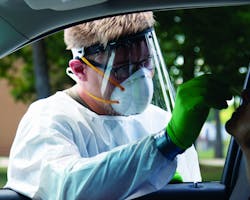Researchers from Chung-Ang University have used gold nanoparticles to develop a new molecular diagnostic platform that reduces the time required for COVID-19 detection
The RT-PCR test, the current diagnostic standard for COVID-19, is considerably time-consuming. To shorten the time required for SARS-CoV-2 detection, researchers have developed what they call an enhanced Raman scattering (SERS)-PCR detection platform — prepared using gold nanoparticles (AuNPs) in the cavities of Au ‘nanodimple’ substrates (AuNDSs) — that can detect viral genes after only 8 cycles of amplification, compared with 25 cycles for RT-PCR.
They published the results of their work in Biosensors and Bioelectronics.
“Conventional RT-PCR is based on the detection of fluorescence signals, so 3–4 hours are required to detect SARS-CoV-2. This speed is not enough considering how rapidly COVID-19 spreads. We wanted to find a way to cut this time at least by half,” says Jaebum Choo, explaining the motivation behind the study.
In a previous study published in 2021, Choo’s team had developed a novel detection platform in which high-sensitivity SERS signals are produced by AuNPs uniformly arranged in the cavities of AuNDSs through a technique called DNA hybridization. Based on this previous discovery, Choo and his team developed the novel SERS-PCR platform for COVID-19 diagnosis.
The newly developed SERS-PCR assay uses SERS signals to detect “bridge DNA”— small DNA probes that slowly break down in the presence of target viral genes. Therefore, in samples from patients positive for COVID-19, the concentration of bridge DNA (and therefore the SERS signal) continuously decreases with progressive PCR cycles. In contrast, when SARS-CoV-2 is not present in the sample, the concentration of bridge DNA and the resultant SERS signal remain unchanged. In this way, SARS-CoV-2 can be rapidly detected in patient samples.
The team tested the effectiveness of their system using two representative target markers of SARS-CoV-2, namely, the envelope protein (E) and RNA-dependent RNA polymerase (RdRp) genes of SARS-CoV-2.
“Although our results are preliminary, they provide an important proof-of-concept for the validity of SERS-PCR as a diagnostic technique. Our AuNDS-based SERS-PCR technique is a promising new molecular diagnostic platform that can considerably shorten the time required for gene detection compared to conventional RT-PCR techniques. This model can be further expanded by incorporating an automatic sampler to develop a next-generation molecular diagnostic system,” explains Choo.

